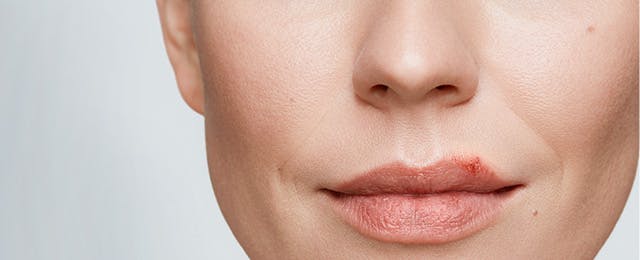
Canker Sore Pain vs. Cold Sore Pain: What's the Difference?
When you experience pain in and around your mouth, it’s important to understand the cause of your discomfort so that you can properly treat it. Apart from the visual cues the physical sensations of pain from a cold sore and a canker sore differ. Learn how to tell them apart so you can start feeling better.
Canker Sores: Pain, Causes & Treatment
Also known as aphthous ulcers, canker sore are lesions that develop in the soft tissues in your mouth.1 They’re commonly found on your tongue, inner lip and at the base of your gumline and they can be painful, making eating and speaking difficult.1
Canker sores aren’t contagious like cold sores and will often go away on their own, but you may experience a tingling or burning sensation before the sore actually appears.1 Canker sores also differ from cold sores because they do not appear on the surface of your lips.1
Canker sore pain can be easy to manage, but they can also last for several weeks and require medical attention.1 These lesions may be recurring and persistent, and make actions like eating and drinking extremely difficult.1
You can treat canker sore pain with over-the-counter numbing agents specifically directed for use with canker sores.2 Take extreme care when using these products, given the sores’ location on the soft tissues of the mouth. Avoid spicy foods or foods that may be considered abrasive.2 Rinse your mouth with an OTC antiseptic solution to help speed healing and prevent infection and further burning or tingling pain.2
Cold Sores: Pain, Causes & Treatment
Cold sores are caused by an infection of the herpes simplex virus and causes the formation of painful, fluid-filled blisters that are usually located on the outside of the mouth around the lips.2 Before these blisters form, they may announce themselves with a distinctive tingle or itching sensation. If left untreated, they’ll quickly grow in a matter of hours.2
Pain from a cold sore is usually due to the speed in which the cluster of fluid-filled blisters appears, leading to pressure, soreness, and a burning sensation.2,3 After they appear, these blisters may turn cloudy and filled with pus; then they dry up, crust over and heal, usually in the span of 7-10 days if left untreated.3 These sores can make eating difficult and applying pressure to them may be painful, with the way that these blisters are pulling on your skin.3
While there’s no way to permanently cure cold sores, you can treat them individually with antiviral medications. You can talk to your doctor about a prescription, or you can reach for over-the-counter Abreva Cream, which — if used at the first sign of a tingle — can heal your cold sore in as little as 2½ days.* Abreva Cream can help heal the viral aspect of your cold sore, but you can also look to other products to manage cold sore pain. Abreva Cold Sore Rapid Pain Relief gel contains the active ingredient lidocaine, and uses a rapid numbing effect to target uncomfortable pressure and throbbing pain.**
Canker and cold sore pain can both put a damper on your day, but understanding their differences can help you treat them effectively.
*Median healing time 4.1 days. 25 percent of users healed within 2½ days.
**Use as directed.
Source Citations:
1. Canker Sore. Mayo Clinic. https://www.mayoclinic.org/diseases-conditions/canker-sore/symptoms-causes/syc-20370615. Accessed 5/3/2023.
2. Fever Blisters & Canker Sores. National Institute of Dental and Craniofacial Research. https://www.nidcr.nih.gov/health-info/fever-blisters-canker-sores. Accessed 5/3/2023.
3. Cold and Canker Sores. University of Michigan Health Service. https://uhs.umich.edu/coldcankersores. Accessed 5/3/2023.
By clicking the link(s) above, you will be taken to an external website that is independently operated and not managed by Haleon. Haleon assumes no responsibility for the content on the website. If you do not wish to leave this website, do not click on the links above.




